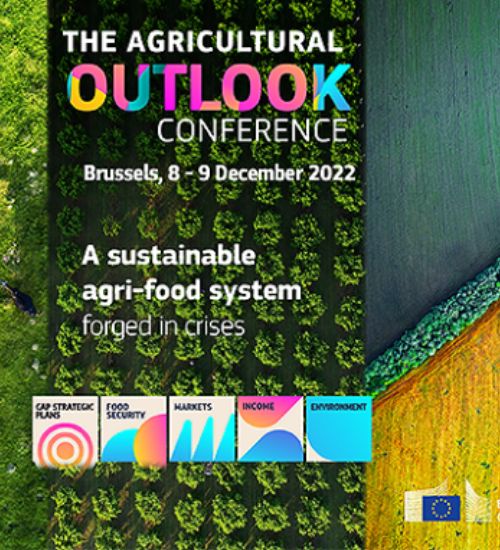
The 2022 edition of the EU Agricultural Outlook Conference attracted more than 500 participants from 38 countries on site and about 3000 participants followed us online from 43 countries.
This is the major annual gathering of all things Common Agricultural Policy. Throughout 8 and 9 December, discussions covered a wide variety of topics, from CAP Strategic Plans to the EU role vis-à-vis global food security, to sustainable food systems to the outlook of agricultural markets. SHERPA partner AEIDL took part in the conference.
Two issues dominated the discussions: the uncertainty in global food supply due to the Ukraine crisis and long term trends such as climate change, and the imminent start on January 1st of the CAP Strategic Plans as all 27 of them have been at last agreed by each Member State and the Commission.
In opening the Conference, EU Agriculture and Rural Development Commissioner Mr Janusz Wojciechowski summed up the present challenges.
Last October food inflation rate rose to almost 18%, endangering the affordability of food for EU citizens, especially those with low incomes. Devastating droughts affected farmers in many parts of Europe this summer, resulting in a reduction of our cereal yield by 8%. Over 200 million people across 53 countries are expected to face acute insecurity of food supply.
CAP and the EU as a whole played a role in confronting these challenges. The Solidarity Lanes allowed over 19 million tonnes of grains to leave Ukraine since May. To compensate for Ukrainan export shortages EU exports increased by 80% to sub-Saharan Africa, and by 40% to the Middle East and the North Africa region.
Last March CAP package resulted in, for the first time, the crisis reserve of the CAP was used, opening up a direct aid package of €500 million. A new special measure in Rural Development was introduced to use uncommitted funds in 2021 and 2022 for aid to farmers and rural businesses. This was combined with looser public subsidy rules for farmers, by way of the so-called Temporary Crisis Framework for State aid.
Still the medium to long term outlook of EU agriculture remains a concerning one. Farmers are getting older, they have 57 years on average, while young farmers between 25 and 44 years old are fast decreasing in numbers.
The number of farms keeps going down. In the past ten years, the number of farms decreased by 3 million, or 25%, to 9.1 million in 2020. Farms are becoming larger and less mixed. Those that combined crops and cattle has decreased 42% over the last decade. Very small farms (below 2 hectares) are decreasing rapidly.
The net result of all this is the loss of 2 million of hectares of farmland since 2010, to 157 million EU wide at present.
This is the context in which the new CAP that will start to apply as of 1 January 2023, including the new additional requirements beyond food production.
Over 80% of all support under the strategic plans contributes to environmental sustainability, affecting 90% of EU agricultural land. It means, for example, that around 30% of the EU agricultural area will be subject to targeted actions to conserve or restore biodiversity. This includes protecting landscape features, covering almost 3 million hectares. One third of support, or almost €100 billion, is dedicated to deliver environmental benefits for climate, water, soil, air, biodiversity, and animal welfare and to encourage practices going beyond the new, and already more ambitious, minimum requirements.
More than 10% of direct support will be allocated to the redistributive payment, resulting in much higher per hectare payments for smaller and medium sized farms. Under the new plans, a total of €8.5 billion will be allocated to support young farmers and generational renewal. A positive development is that that 31% of farms are now managed by women, and many of these farms are managed by women under 40.
The EU’s rural areas host 30% of EU population and occupy 83% of the territory. The second pillar of the CAP (Rural Development) is key to the new EU Long-Term Vision for Rural Areas, which sets out thirty actions for stronger, connected, resilient and prosperous rural areas, with all Commission departments involved.
The Rural Pact, launched in June this year and whose secretariat will launch also on January, has brought together all levels of governance, all policies, public and private players to collaborate towards a better future for rural places. The Rural Pact community has already 1,200 signatories. In fact, the Czech Republic has launched its own national Rural Pact.
There are challenges but also some space for hope. At the end of 2023, the Commission will publish a first report to assess the joint effort of all CAP Strategic Plans. This report will provide a first insight of the working of the strategic plans and where adjustments can be made. Furthermore, even if 2023 is the first year of the new CAP is being deployed on the ground, the EU institutions and other stakeholders is already thinking on the post 2027 CAP and indeed all other EU policies. Despite being the largest EU budget heading making up about 1/3 of the EU budget CAP just represents 0.4% of the EU GDP.
Published by Serafin Pazos